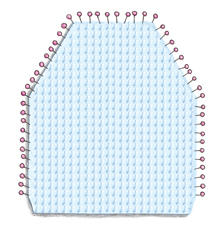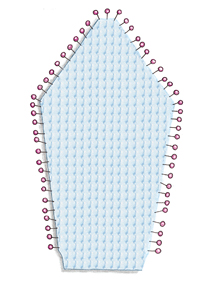Blocking
Although the word “blocking” sounds ominous, like something that should be avoided, it’s actually one of the most important steps to successfully completing your garment. In essence, blocking is a method of shaping and molding your crocheted pieces to match the measurements and shapes on the schematics. Blocking will also remove wrinkles and creases that might occur if the pieces have been folded.
Keep in mind that blocking is only to shape and not to correct mistakes by making a piece wider or longer so it matches another piece. Unlike most grunt work, the payoff to a successfully blocked garment is huge. With some time and effort the end result will be a beautiful sweater that looks lovingly handmade rather than a homemade mess.
There are two main categories of blocking: wet and steam. To know which one to use with the yarn that was used for your project, refer to the ball band for the fiber content and to the pressing guide below. To get started, gather up all the supplies you’ll need, including the schematics or the measurements from the pattern. The schematics and measurements will serve as a blueprint for you to follow, so you’ll know exactly what size and shape the pieces should be stretched and molded into.
WET BLOCKING
There are two ways to wetblock your crocheted pieces. Both techniques work equally well, so choose the one that appeals to you most. The first is to immerse the pieces in cool water, then squeeze out the water, taking care not to wring or twist them. Working one at a time, place the piece on a flat, covered, padded surface (or a blocking board), then stretch and mold the piece into the same size and shape shown on the schematic. Referring to “Pinning and Blocking,” pin the key edges to hold the piece in shape until it is totally dry. Depending on the room temperature and humidity, drying time can be in excess of twenty-four hours, so just be patient. The second method is to pin the pieces first (following the schematics), then wet them down using a spray bottle filled with cool water. Again, leave them be until they are dry. And no cheating! If you unpin pieces that are even slightly damp, they will lose the blocked shape and you will have to start all over again!STEAM BLOCKING
To steamblock, first pin the pieces on a flat surface following the measurements on the schematics. Set your steam iron on the lowest setting that will still produce steam, or use a handheld steamer. Once you have a good steam going, hold the iron or steamer close to the fabric, then work in a circular motion over the entire piece until every inch is evenly dampened. DO NOT touch the iron to the fabric! If you find that you must lightly press the piece, cover it with a colorfast towel or a pressing cloth to protect the fabric from the hot metal plate. Drying after steaming takes a lot less time than wet blocking, but you still must allow the pieces to dry thoroughly before unpinning.pinning and blocking

1. Pin the key areas as shown, omitting the bottom edge. For perfectly straight edges, make sure to space the pins evenly

2. Following the schematic, use a tape measure to make sure you pin the piece evenly to the padded surface.
pressing guide
All fibers react differently to heat, so it’s a good idea to know what to expect before you press or steam them (or even if you should). Many yarns are a combination of fibers, so you should choose a method that is compatible with all the contents. Read the ball band to see what fiber has the highest percentage, then go with the recommended method for that fiber first. Test the method on your gauge swatch to see the results and determine if you have to make any adjustments before committing the technique to your garment pieces.
| Angora | Wet block by spraying |
| Cotton | Wet block or warm/hot steam press |
| Linen | Wet block or warm/hot steam press |
| Lurex | Do not block |
| Mohair | Wet block by spraying |
| Novelties | Do not block, unless there are specific blocking directions |
| Synthetics | Carefully follow instructions on ball band—usually wet block by spraying, do not press |
| Wool and all wool-like fibers (alpaca, camel hair, cashmere) | Wet block by spraying or warm steam press |
| Wool blends | Wet block by spraying; do not press unless pretested first |
blocking supplies
1. Flat, covered, padded surface large enough to hold one piece of crochet and thick enough to insert and hold pins (such as a carpet or mattress covered with plastic and a towel). Or you might want to invest in a blocking board, which is easier to use and more convenient (although a little pricey).
2. Rustproof T-pins or glass-headed pins. Do not use pins with plastic heads. They will melt when they come in contact with heat.
3. Tape measure
4. Schematic for the sweater you are blocking
5. Colorfast towels
6. Spray bottle with cool water or a sinkful of cool water
7. Steam iron or handheld steamer
8. Pressing cloth
